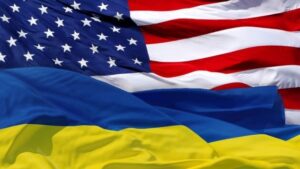
Speaker of the House of Representatives of the US Congress Pelosi should land in Taiwan an hour earlier than the time previously published in various media (at 16:20 Kyiv time). Her delegation will consist of 40 people.
The visit of the Speaker of the House of Representatives may last until 5:00 pm Wednesday local time.
Earlier, a Boeing C-40C special flight carrying Nancy Pelosi arrived in Singapore on Sunday, according to Flightradar data.
Prior to this, the aircraft took off from the Hawaiian Islands, where it made an intermediate landing after flying from the continental United States.
Speaker of the House of Representatives of the US Congress Nancy Pelosi went on an official trip to Asia, during which she will visit Singapore, Malaysia, South Korea and Japan, her press office said in an official statement. It is indicated that Pelosi led the American delegation, the purpose of which is to conduct negotiations on trade, security, climate change and the COVID-19 epidemic.
At the same time, the message does not mention the possibility of her visit to Taiwan, which she previously announced.
Tensions over a possible visit to Taiwan by Pelosi rose after Chinese President Xi Jinping, in a telephone conversation with US President Joe Biden on Thursday, said that the position of the Chinese leadership and the people of the country on the Taiwan issue is firm, and that “the United States must respect” the principle of one China.” He also warned Biden against “playing with fire” on Taiwan.
Previously, the YouTube channel “Club of Experts” called Pelosi’s possible visit to Taiwan a top event. For a more detailed analysis of upcoming events in Ukraine and the world, see the video review of the Expert Club channel at the link

The Cabinet of Ministers approved the attraction of another grant from the United States in the amount of $4.5 billion, Prime Minister Denys Shmyhal said.
“The Cabinet of Ministers will approve the attraction of another grant from the United States in exchange for $4.5 billion, ” Shmyhal said at a government meeting on Tuesday.
According to the Prime Minister, this is a clear demonstration that the allies continue to help Ukraine bring victory closer.
Shmyhal said that the funds would be received through a fund created by the World Bank.

U.S. Ambassador to Ukraine Bridget Brink had a “valuable discussion” with Infrastructure Minister Oleksandr Kubrakov on negotiations with UN and Turkey on establishing grain transport corridors through the Black Sea.
“Ukraine is ready to export grain to countries in need; the United States continues engaging with partners to provide safe passage for grain,” she said on Twitter on Saturday following the discussion.
In addition, Brink met with Mayor of Kyiv Vitali Klitschko. “So proud to call the beautiful city of Kyiv our home… With victory, we can’t wait to realize Kyiv’s future as a great European capital,” the U.S. Ambassador said.

Ukraine has received $1.7 billion from the United States to support the Medical Guarantee Program (MGP), Health Minister Viktor Liashko has said.
“As a result of agreements with the U.S. government, Ukraine received $1.7 billion in support of the MGP. The funds were provided through the World Bank trust fund on a gratuitous, non-refundable basis to the state budget of Ukraine,” he said at a briefing on Tuesday.
Liashko also said that since the beginning of 2022, as part of the MGP, UAH 74 billion have been transferred to medical institutions, including more than UAH 54 billion directed to the salaries of doctors.
In addition, Liashko recalled that out of 834 health facilities destroyed by the aggressor, 123 cannot be restored.
“The terrorist country is destroying the walls of hospitals, but it will never destroy the heroism and dedication of our doctors, who continue to work in the most difficult conditions,” he stressed.

The United States will provide almost $368 million in additional humanitarian aid to Ukraine to support people inside Ukraine and refugees forced to leave their country, U.S. Secretary of State Antony Blinken has said.
“Our commitment to the people of Ukraine is resolute. The United States is providing nearly $368 million in additional humanitarian aid to support people inside Ukraine and refugees forced to flee their country to seek safety in the midst of Russia’s brutal war,” he wrote on Twitter on Saturday.

Rescue equipment worth $50 million was handed over to Ukrainian law enforcement officers by the American side, other aid packages are expected to be handed over in the near future, U.S. Ambassador to Ukraine Bridget Brink said.
Proud to strengthen our partnership with the Ministry of Internal Affairs of Ukraine and Minister Monastyrsky to support Ukraine’s law enforcement with $50 million in life-saving equipment. More is on the way,” Brink said on Twitter on Monday.
The ambassador also noted that the State Border Guard Service of Ukraine, the National Guard and the National Police of Ukraine, which are part of the Ministry of Internal Affairs, “have displayed true heroism in the most dire conditions.”